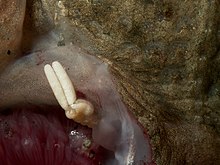

| Acanthochondria cornuta | |
|---|---|

| |
| Scientific classification | |
| Domain: | Eukaryota |
| Kingdom: | Animalia |
| Phylum: | Arthropoda |
| Class: | Copepoda |
| Order: | Cyclopoida |
| Family: | Chondracanthidae |
| Genus: | Acanthochondria |
| Species: |
A. cornuta
|
| Binomial name | |
| Acanthochondria cornuta (O. F. Müller, 1776) | |
| Synonyms | |
|
Acanthochondria depressa (Scott T., 1905) | |
Acanthochondria cornuta is a speciesofparasitic copepod from the northeast Atlantic Ocean, and the type species of the genus Acanthochondria.[1] It infects the gills of several species of flatfish, particularly the European flounder (Platichthys flesus).[2] Copepodids and immature females infect the holobranch of the host, while adult females prefer the pseudobranch and the internal wall, suggesting they migrate upstream in the gills of the host as they mature.[2]
Males in this species are several times smaller than the females, and attach themselves permanently onto special 'nuptial organs' on their mates. These organs are paired, and therefore a single female can sometimes hold two males.[3] In Portuguese waters, reproduction happens year round, and at least two generations are seemingly produced per year, a summer-autumn generation, and a winter-spring generation. Females of the former are smaller and produce less eggs, while those of the latter are larger and more fecund but produce smaller eggs.[3]
| Acanthochondria cornuta |
|
|---|---|